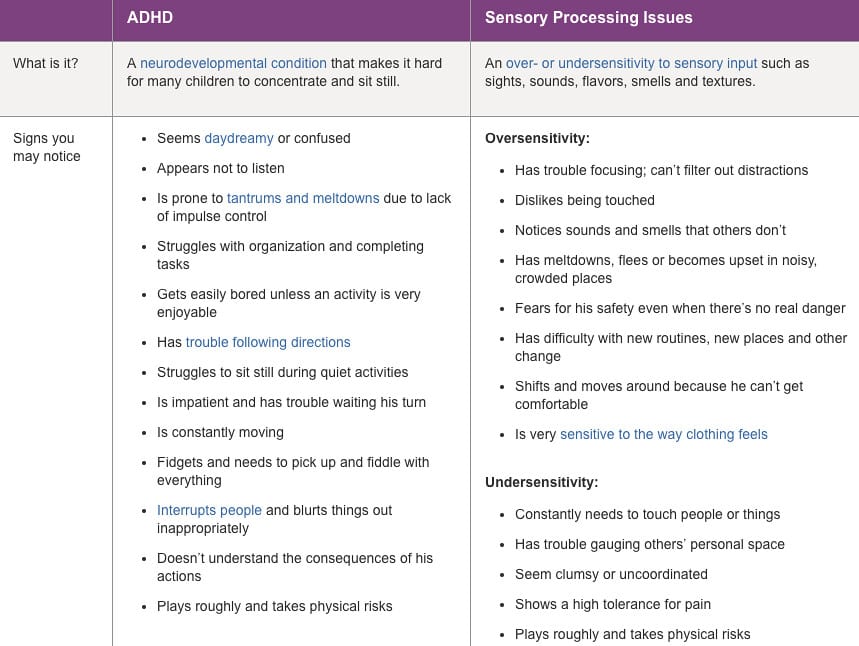Welcome to a Parent’s Guide on Sensory Processing Disorder and ADHD
Hello amazing parents and caregivers! Are you ready to dive into the colorful world of Sensory Processing Disorder (SPD) and Attention Deficit Hyperactivity Disorder (ADHD)? I bet you are! Navigating the journey with a child who has SPD or ADHD can be like trying to solve a tantalizing puzzle. But don’t you worry; we’re here to explore this topic together with joy, empathy, and a sprinkle of fun!
What Is Sensory Processing Disorder?
First thing’s first—let’s unravel the mystery called Sensory Processing Disorder. Imagine a bustling marketplace; sights, sounds, smells all around. For most, it’s a lively experience, but for kiddos with SPD, it can be overwhelming. Their brains have a unique way of responding to sensory information, which means sometimes they may react more intensely to touch, sound, or motion, or conversely, might not react at all.
And Let’s Not Forget ADHD
Mix in Attention Deficit Hyperactivity Disorder (ADHD), and the complexity deepens. With ADHD, staying focused is like trying to catch a fluttering butterfly. Children might dart from activity to activity, leaving a trail of unfinished tasks, or they might daydream, missing the important details.
Understanding the Connection
So, you might wonder—how do these two play together? Actually, it’s quite common for kiddos to be invited to both the SPD and ADHD parties. When that happens, figuring out each condition’s role can be pretty tricky.
Symptoms to Watch For
Being the super-sleuth you are, you’ll want to know about symptoms that may signal SPD or ADHD:
- SPD Symptoms: Over or under-reaction to sensory stimuli, trouble with coordination, being unusually clumsy, issues with eating or dressing, and problems with handwriting.
- ADHD Symptoms: Difficulty maintaining attention, impulsive actions, constant movement, frequent interrupting, and forgetfulness in daily activities.
Early Intervention is Key
Catching these clues early on can make a world of difference. Early intervention can pave the way for success in school, making friends, and just generally rocking at life.
Strategies to Support Your Super Kid
But what super tools can you have in your parenting utility belt? Well, knowledge is power! Understanding your child’s sensory preferences, crafting a structured environment, and consistent routines can be game-changers. Plus, therapies like Occupational Therapy, with a focus on Sensory Integration, might just be the superhero sidekick you need.
There’s so much more to unpack in our sensory and ADHD adventure. Stay tuned as we delve into diagnosis, treatment options, and daily living tips that will transform your parenting approach and empower your amazing little one to reach their fullest potential. Every child’s sensory and attention journey is as unique as a fingerprint, and we’re here to help you trace its beautiful lines with care, understanding, and a little bit of joyful anticipation for the amazing growth that lies ahead.
Remember, dear parent, you’re not on this path alone. With the right information and a community of support, we can navigate these waters together, making sure every child has the opportunity to shine in their own wonderful way.
Continue to join us as we provide you with a treasure chest of insights on fostering an environment where children with SPD and ADHD can thrive. Stay excited, as we’re about to take an even closer look at the sensory trampoline and the ADHD rocket ship—next stop, personalized strategies for home and school!
So buckle up, because here we go, off on our adventure to learn, support, and celebrate our children’s unique sensory and attention experiences.

5 Things Parents Should Know in Preparing for Sensory Processing Disorder and ADHD in Children
1. Recognize the Red Flags
Identify the signs and symptoms of SPD and ADHD early. These can range from difficulty paying attention to an unusual sensitivity to clothes or light touch. Knowledge of these red flags can hasten the route to diagnosis and support.
2. Seek a Supportive Team
Assemble a team of professionals who understand SPD and ADHD. This may include pediatricians, neurologists, psychologists, and occupational therapists. An integrated approach can yield the best outcomes for your child.
3. Create a Sensory-Friendly Environment
Construct an environment at home that reduces sensory overload. Soft lighting, quiet spaces, and sensory toys can help a child with SPD feel safe and calm. Consistency and structure are also important for children with ADHD to thrive.
4. Embrace Strategies for School Success
Collaborate with your child’s school to create an Individualized Education Program (IEP) or 504 Plan. These can provide accommodations that align with your child’s unique needs, such as preferential seating, extra time on tests, or breaks during the school day.
5. Foster Social and Emotional Skills
Children with SPD and ADHD may face challenges in social situations. Help them develop these skills through role-playing, social stories, or organized activities. Emotional coping strategies are equally important and can be nurtured through mindfulness or therapy.
With patience and perseverance, parents can be the guiding light in their child’s journey through SPD and ADHD. Keep in mind the value of taking care of yourself, too, so that you can be the very best advocate and support system for your incredible kiddo. Embrace this adventure with optimism and love and watch as your child unveils their unique strengths and talents, one delightfully unexpected moment at a time.
Armed with understanding, support, and a treasure trove of strategies, parents are the unsung heroes in the narrative of SPD and ADHD. Empower your child by fostering their inherent strengths, providing unwavering love, and shaping a world where they can boundlessly explore, learn, and grow. Here’s to your magnificent journey—filled with discovery, resilience, and boundless joy!
See more great Things to Do with Kids in New Zealand here. For more information see here
Disclaimer
The articles available via our website provide general information only and we strongly urge readers to exercise caution and conduct their own thorough research and fact-checking. The information presented should not be taken as absolute truth, and, to the maximum extent permitted by law, we will not be held liable for any inaccuracies or errors in the content. It is essential for individuals to independently verify and validate the information before making any decisions or taking any actions based on the articles.




